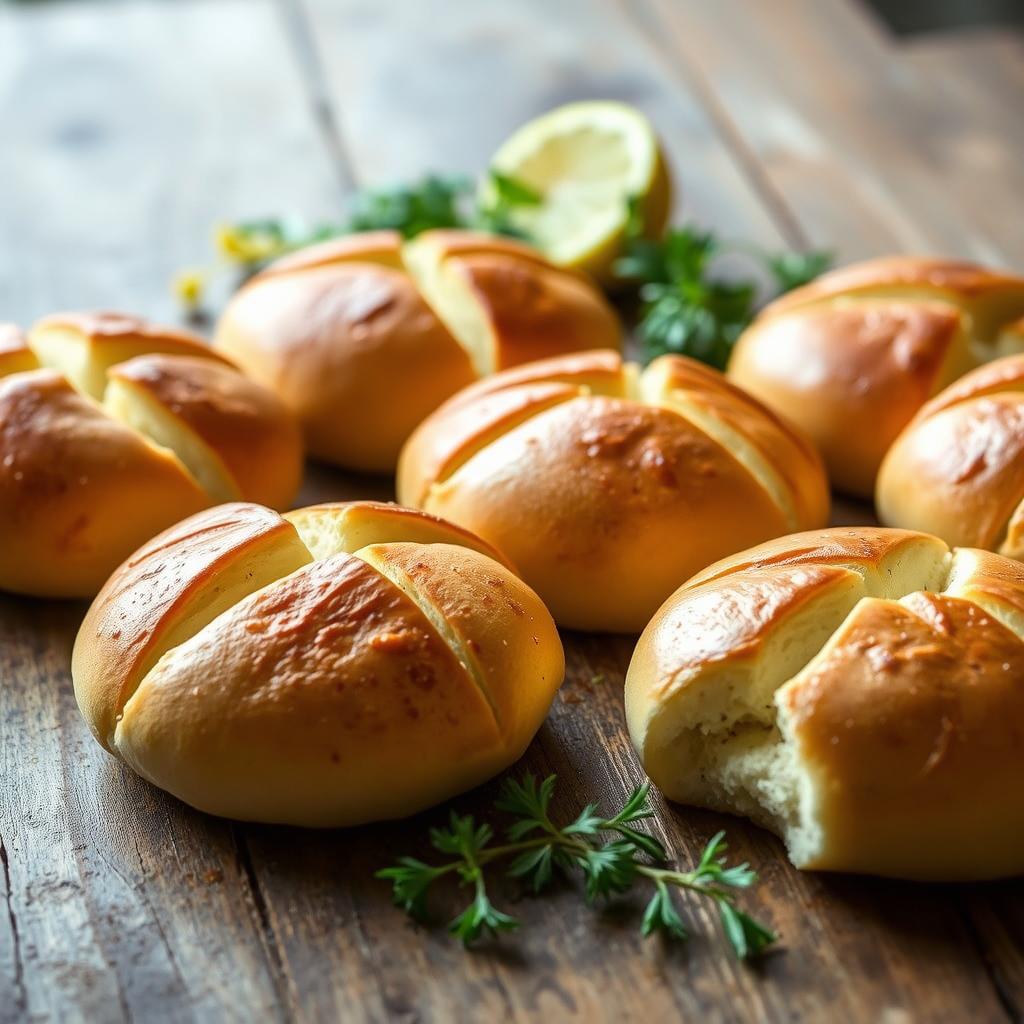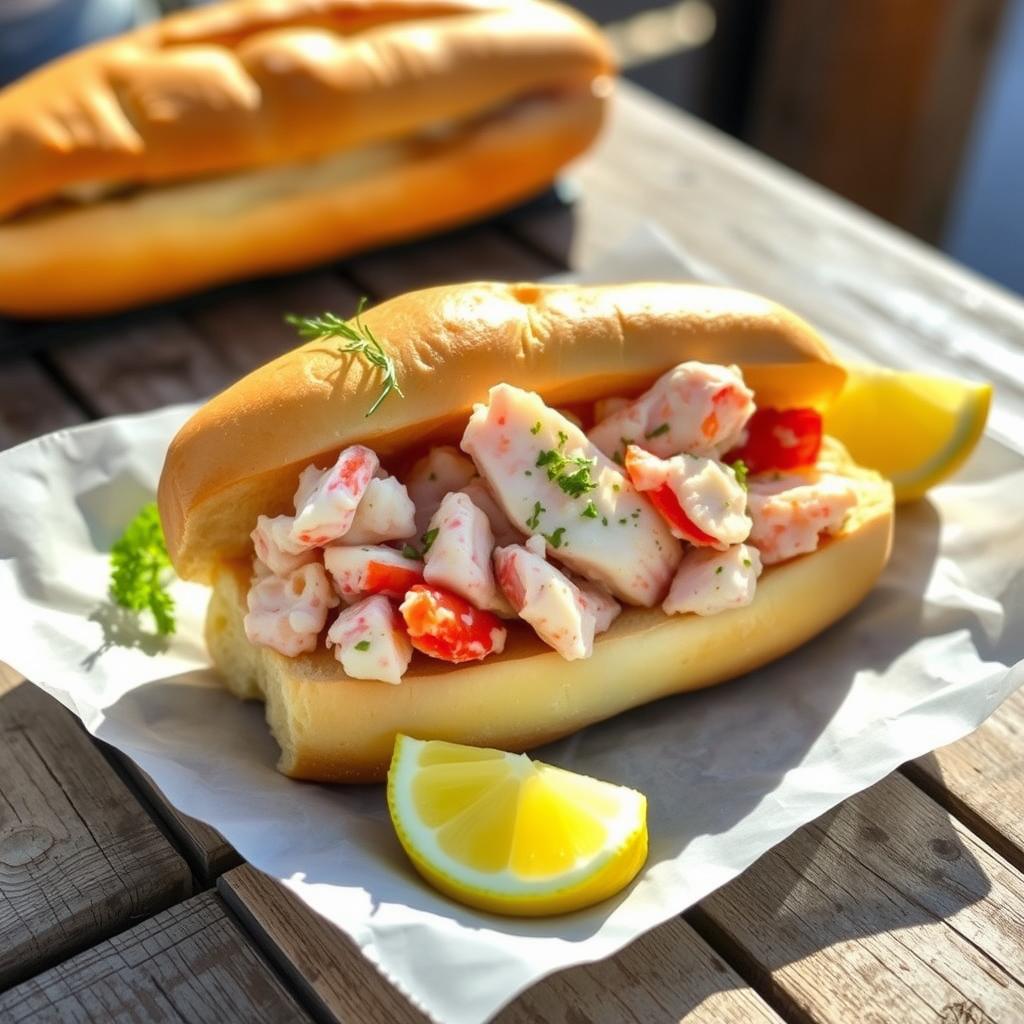Growing up by the coast in New England, lobster rolls brought back happy summer days. The smell of fresh lobster and the taste of buttery buns were unforgettable. It was a taste of the region’s rich sea heritage.
Even as I’ve traveled the world, those lobster roll memories stay with me. They remind me of comfort and home.
Key Takeaways
- Connecticut-style lobster rolls feature warm, butter-drenched lobster meat in toasted buns.
- The dish originated in the 1920s as a simple, yet flavorful way to enjoy the region’s abundant seafood.
- Key ingredients include fresh lobster meat, butter, lemon, and split-top buns.
- This recipe balances simplicity with rich, indulgent flavors that allow the natural sweetness of the lobster to shine.
- Lobster rolls have become an iconic summer dish across New England and beyond.
The Rich History of New England Lobster Rolls
The lobster roll is a beloved part of New England’s cuisine. It has a rich history tied to the region’s maritime culture. It started in the early 20th century as a meal for fishermen. Now, it’s a celebrated dish that shows the bond between coastal communities and their seafood.
Origins in the 1920s Maritime Culture
The lobster roll first appeared in 1929 at a restaurant in Milford, Connecticut. Lobsters were cheap and plentiful back then. Fishermen used them to make simple, tasty sandwiches, starting the lobster roll’s journey.
Evolution from Fishermen’s Meal to Culinary Icon
In the 1920s, mayonnaise was added to the lobster roll. This change made it more refined and appealing. It quickly became famous in Maine, Massachusetts, and Connecticut, with each place adding its own twist.
Regional Variations and Traditions
There are two main types of lobster rolls: the warm Connecticut roll and the chilled Maine roll. The Connecticut roll is warm and buttery, while the Maine roll is cold and mayonnaise-based. New York and New Jersey have their own versions, adding lemon juice or Old Bay seasoning.
Now, lobster rolls are enjoyed in fancy restaurants and food trucks. Their appeal has grown thanks to social media. This has made the lobster roll a true icon of New England’s cuisine.
Connecticut Style vs Maine Style Lobster Rolls
The battle between Connecticut-style and Maine-style lobster rolls has long fascinated seafood lovers in New England. These two styles offer unique flavors and textures, each with its own fan base.
Connecticut-style lobster rolls are warm and tender, dressed in melted butter. This highlights the lobster’s pure taste. Maine-style rolls, on the other hand, are chilled. They mix lobster meat with creamy mayonnaise, lemon juice, and diced celery for a richer flavor.
Both styles use a split-top bun, but the lobster’s temperature sets them apart. Connecticut rolls are warm, with the butter melting over the lobster. Maine rolls are chilled, making them creamy and refreshing.
The choice between these lobster roll variations often depends on personal taste. Some prefer the simple, buttery taste of Connecticut rolls. Others enjoy the creamy, complex flavor of Maine rolls. It’s all about what you like best and the New England seafood styles you prefer.
Despite their differences, the lobster roll’s popularity across New England remains strong. It’s a true New England delicacy, thanks to regional cuisine differences.
| Connecticut-Style Lobster Roll | Maine-Style Lobster Roll |
|---|---|
| Warm lobster meat dressed in melted butter | Chilled lobster meat mixed with mayonnaise, celery, and lemon juice |
| Emphasizes the pure, unadulterated flavor of lobster | Offers a creamier, more complex taste profile |
| Served in a toasted split-top bun | Served in a toasted split-top bun |
| Preferred by those who enjoy rich, buttery flavors | Preferred by those who enjoy cold seafood salads |
Whether you love the warm, buttery Connecticut-style or the chilled, creamy Maine-style, New England’s lobster roll variations are a hit. They showcase regional cuisine differences and delight seafood fans everywhere.
Essential Ingredients for Lobster Rolls with Lemon-Butter Sauce
Making the perfect lobster roll starts with the best ingredients. You need fresh lobster meat and soft split-top buns. The lemon-butter sauce is the final touch that makes it all come together.
Selecting the Perfect Lobster Meat
The best fresh lobster selection is the knuckle and claw meat. They are soft and tender. Look for lobsters that are firm and smell sweet. If fresh lobster is hard to find, frozen pre-cooked meat is a good choice.
Choosing the Right Buns
For a lobster roll, use split-top buns. They are soft and lightly grilled. Brioche buns are also a tasty option.
Key Sauce Components
- Unsalted butter: The base of the sauce, adding creaminess.
- Fresh lemon juice and zest: Add a bright, citrusy flavor.
- Fresh herbs: Chopped chives or herbs give a fresh finish.
Choosing the right lobster roll ingredients will help you make a delicious lobster roll. It will taste like a true New England dish.
Preparing Fresh Lobster for Your Rolls
Creating the perfect lobster rolls starts with fresh lobster meat. Preparing the lobster might seem hard, but it’s easy with a few steps. This way, your rolls will have the tender, sweet flavor everyone loves.
- First, sedate the live lobsters. Put them in the freezer for 20-30 minutes. This makes them easier to handle.
- Next, boil a large pot of salted water. Carefully add the lobsters and cook for 4 minutes per pound. Or, steam them for 8 minutes per pound. This cooks the meat right without making it tough.
- Then, put the cooked lobsters in an ice bath. This stops the cooking and keeps the meat tender and flavorful.
- Finally, take out the meat from the tails, claws, and body. Make sure there’s no shell or cartilage left. Cut the meat into big pieces, keeping the claws whole if you like.
If you’re using pre-cooked lobster meat, thaw it properly and pat it dry. Handling the seafood gently is key. It keeps the meat’s delicate texture and flavor, making your lobster rolls truly special.

The Art of Making Lemon-Butter Sauce
Making the perfect lemon-butter sauce is all about balance. You need to mix the creamy butter with the zesty lemon. Start with unsalted butter to control the salt. Melt the butter slowly over low heat, avoiding any browning.
Proper Butter Selection and Preparation
The lemon-butter sauce starts with high-quality, unsalted butter. This keeps the flavors clean and clear. Melt the butter slowly, stirring now and then, until it’s smooth. This way, you keep the butter sweet and prevent it from getting too dark.
Balancing Flavors with Citrus
Adding fresh lemon juice and zest brings a bright, tangy taste. Start with half a lemon’s juice and adjust to taste. This keeps the lobster roll dressing balanced between creamy and citrusy. The lemon zest adds more citrus aroma and flavor, making the seafood flavoring even better.
Incorporating Fresh Herbs
Adding fresh herbs like chives, parsley, or tarragon adds depth. Chop them finely and mix them in gently. These herbs not only look great but also add a fresh taste that goes well with lobster.
The lemon-butter sauce should be warm and silky. It should highlight the lobster’s sweetness without being too strong. Heat the lobster in the sauce before putting it in the rolls. This lets the flavors blend perfectly.
Proper Bun Selection and Preparation Techniques
Choosing the right bun is key to a great lobster roll. Traditional New England-style split-top buns are the best. They toast evenly and add a nice texture contrast to the lobster.
If you can’t find split-top buns, brioche hot dog buns are a great substitute. They’re soft and buttery, which complements the lobster’s richness.
To get your buns ready, brush them with melted butter on both sides. This will make them golden brown and crispy when toasted.
There are a few ways to toast your buns perfectly:
- On a griddle or in a skillet over medium heat, toast the buttered buns for 1-2 minutes per side until golden brown.
- Alternatively, you can broil the buttered buns for 1-2 minutes, keeping a close eye to prevent burning.
The goal is to get a crispy, toasted bun. This will be the perfect base for your split-top buns, toasting techniques, and lobster roll assembly.
| Bun Type | Toasting Method | Toasting Time |
|---|---|---|
| New England-style Split-Top Buns | Griddle or Skillet | 1-2 minutes per side |
| Brioche Hot Dog Buns | Broiler | 1-2 minutes |
Mastering bun selection and preparation is crucial. It ensures a perfect balance of textures and flavors in every bite of your lobster roll.

Step-by-Step Assembly Method
Making the perfect lobster roll is an art that needs careful steps. Start by lightly toasting the buns until they’re golden and crisp. This step is key to balancing the soft lobster meat.
Next, toss the lobster meat with lemon-butter sauce. Make sure it’s coated evenly. This lets the flavors mix well together.
Layering Components
Put the lobster meat into the toasted buns, letting some spill over. This makes the lobster roll look inviting. For a richer taste, drizzle some warm lemon-butter sauce on top.
Sauce Application Techniques
The lemon-butter sauce is crucial. Use a spoon to spread it over the lobster. This way, every bite has the right mix of citrus and creaminess.
Final Garnishing Tips
- Add chopped chives on top for a fresh taste.
- Place a lemon wedge on the side for extra citrus.
- Use a bit of celery salt for extra flavor.
- Enjoy the lobster rolls right away for the best taste and texture.
By following these steps, you’ll make lobster rolls that look great and taste amazing. They’ll be a hit with anyone who tries them.
Professional Tips for Perfect Lobster Rolls
To get the best results, don’t overcook the lobster. This keeps it tender. Use a mix of claw, knuckle, and tail meat for different textures. Prepare the lobster meat just before serving for the freshest taste.
Balance the richness of butter with a squeeze of lemon for better flavors. Toast the buns right before filling to keep them crisp. Serve the lobster rolls quickly to avoid them getting soggy. Offer both warm (Connecticut-style) and chilled (Maine-style) options to please everyone.
Try adding a bit of Old Bay seasoning or finely minced shallots for extra flavor. These lobster roll techniques, seafood preparation tips, and culinary advice will help you make the perfect lobster rolls. They’ll highlight the sweet, briny taste of Maine lobster.
